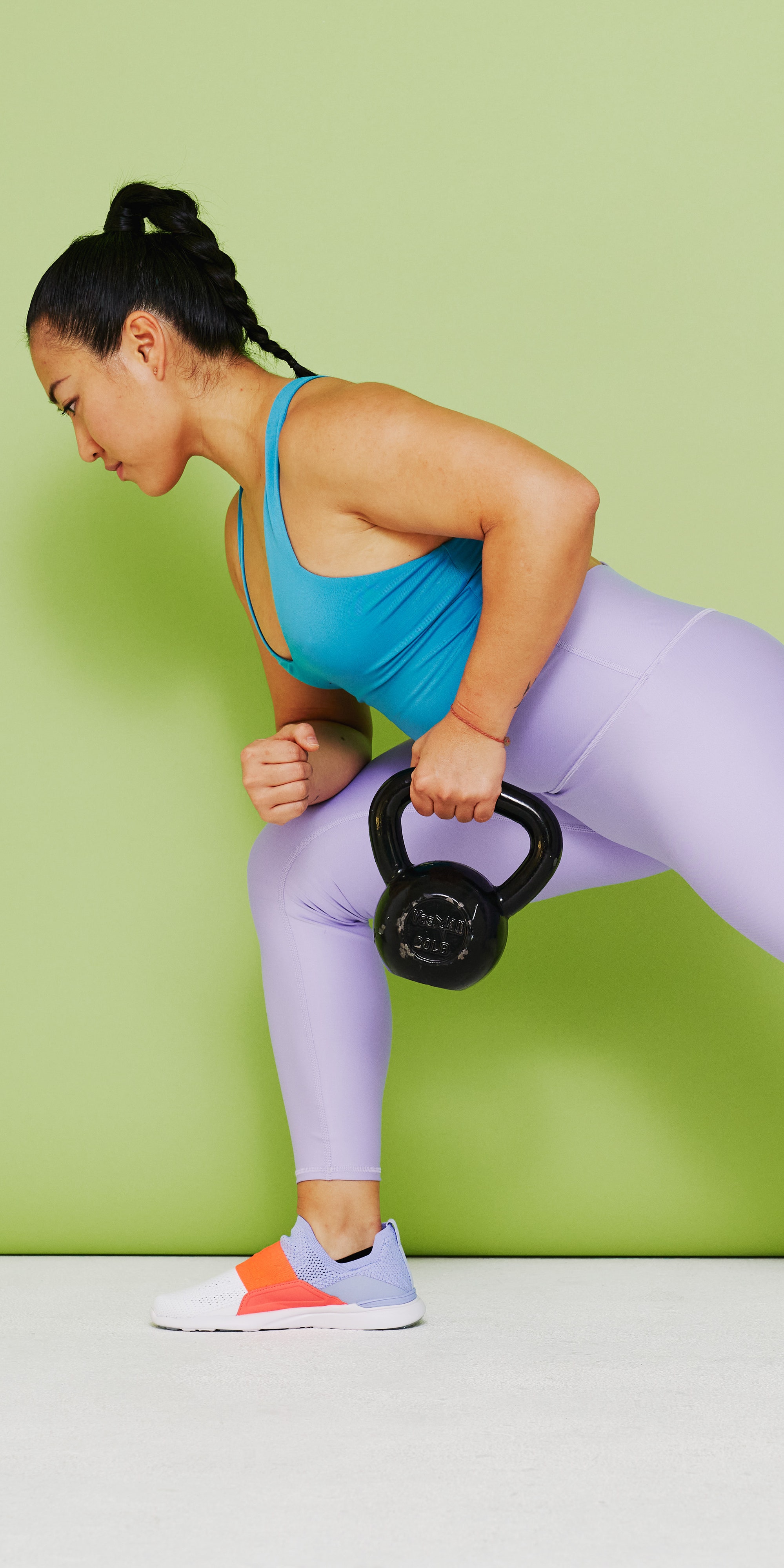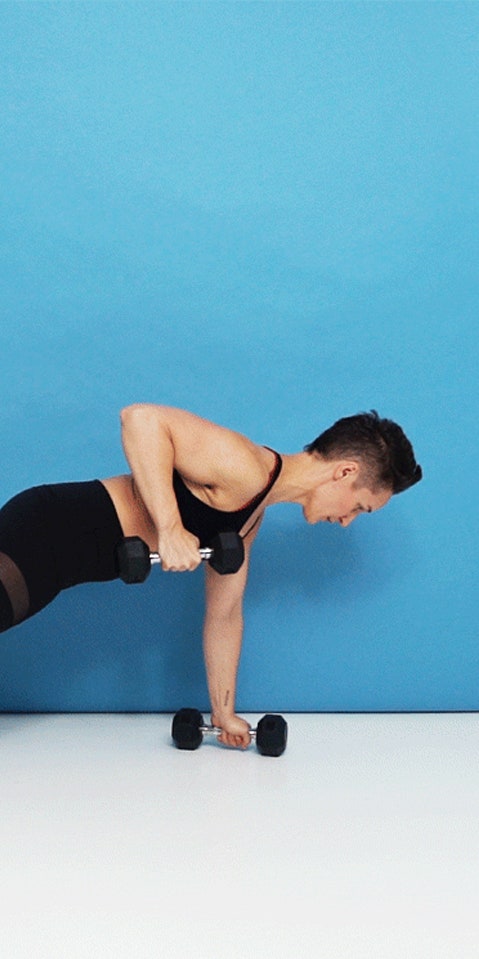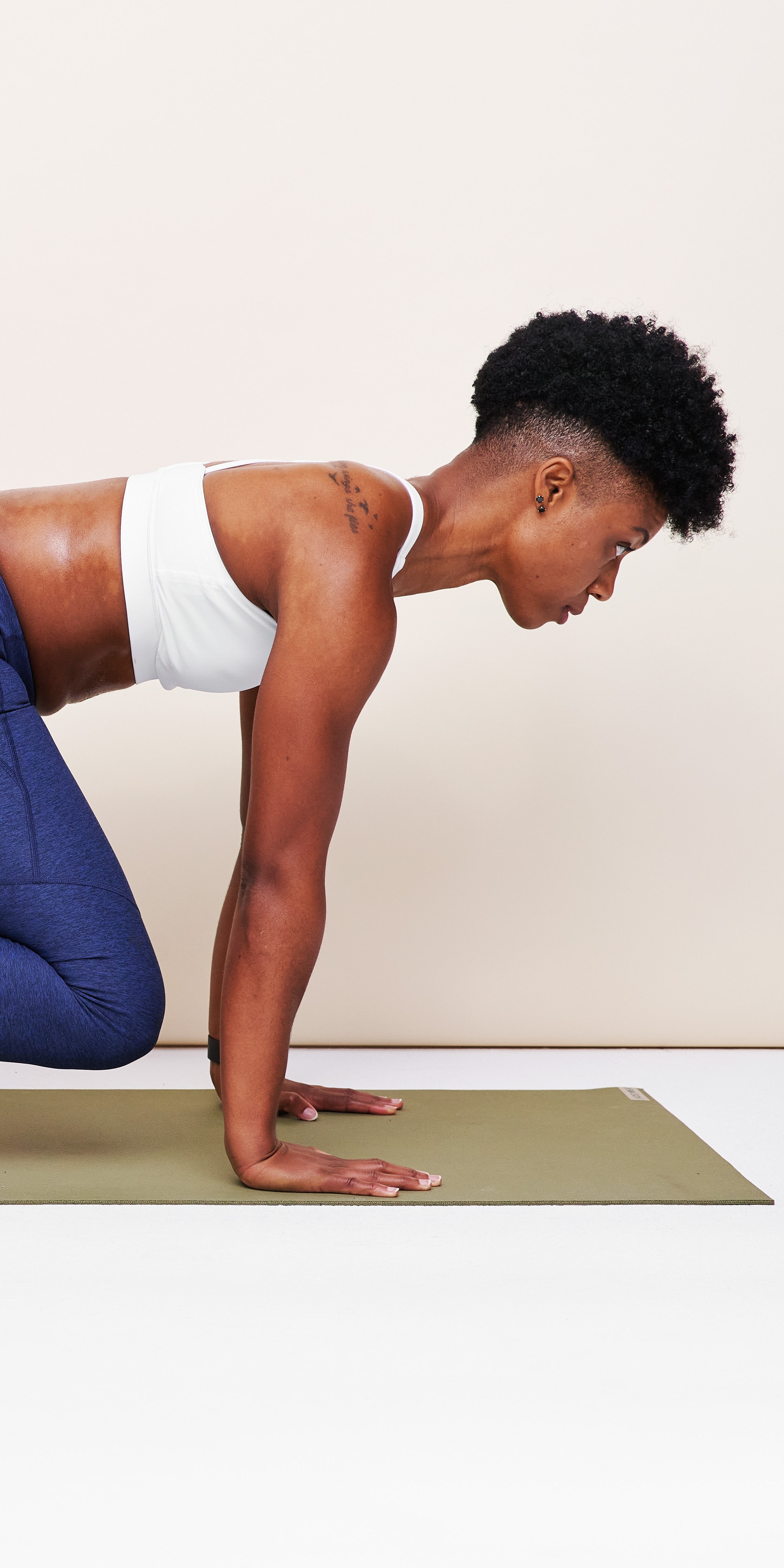
In an ideal world, you’d have access to tons of different fitness equipment to really target all your muscle groups. But when your supply is limited? A single-kettlebell workout can still provide great full-body strength work.
In order to really challenge all your muscles when you have just one set weight at your disposal, you’ll likely need to tweak the reps for the moves accordingly, ACE-certified personal trainer Sivan Fagan, owner of Strong with Sivan, tells SELF. For instance, you’ll likely be able to perform more reps of exercises that work larger muscle groups, like your legs, versus those that target smaller muscle groups, like your shoulders. So for a single-kettlebell workout to be effective for your body, you really need to pay attention to how your body is feeling and adjust your rep count up or down as needed.
That’s exactly what’s on the schedule for the full-body workout Fagan created for SELF below that uses just one medium-weight kettlebell. In the workout, you’ll take on four exercises to work your whole body: quads and glutes (split squat), core (windmill), back (single-arm row), and shoulders (single-arm push-press). You’ll be given the same rep range for the split squat, single-arm row, and single-arm push-press, and a slightly lower rep range for the windmill, but note that the ranges are simply “a general recommendation,” Fagan says. For example, with the split squat, you may find that your muscles can still handle more even after you’ve passed the top of the rep range. But with the windmill, you may find that even the lower rep range is still very challenging since that exercise demands a lot of stability from the shoulder, a small muscle group that typically isn’t able to handle a ton of load.
That’s why it’s really important with this workout to pay close attention to your form—and more specifically the number of reps you can do before that form starts to falter. You’ve found the correct number of reps when your muscles feel tired, and may only be able to eke out a rep or two before your form starts to break down. That may be below the suggested rep range or above it, which is completely okay!
Overall point is: Get mindful with this workout and really tune into how your muscles are feeling. When you need to tack on a few reps do it, and vice versa with backing off. With that approach, you’ll really challenge a ton of different muscles across your body, from your legs and butt to your biceps, shoulders, and back. In addition, you’ll seriously fire up your core in every movement here, since all four exercises are unilateral, meaning just one side of the body is working at a time. Compared to bilateral moves where both sides of the body work simultaneously, unilateral exercises require more core activation since your midsection muscles have to fire to prevent your body from twisting, leaning, or bending to the side as it naturally wants to do, Fagan explains.
You can do this workout two to three times a week, Fagan says, though she caveats that it’d be best to supplement it with another type of workout that includes movement patterns not featured here, such as hip hinging motions (like hip thrusts) as well as horizontal pushing motions (like push-ups).
Before starting this routine, take a few minutes to do a dynamic warm-up so that you fully prep your body for the work ahead. Fagan recommends a simple three-move routine: striders (the first move in this sequence), inner thigh mobility drill, and side-lying rib rotation. Do about three to six repetitions per side of each move and you’ll be ready to rock.
With that, let’s dig into this awesome, total-body workout you can do with just one kettlebell!
The Workout
What you need: One medium weight kettlebell. Aim for something between 8 to 10 pounds, Fagan suggests. If you have access to more kettlebells, you can vary the weight per move (heavier with the split squat, lighter with the windmill, and mid-weight for the row and push-press, for instance) so you can hit similar numbers of reps for each.
Exercises
- Split squat
- Windmill
- Single-arm row
- Single-arm push-press
Directions
- Complete 12–15 reps of the split squat, single-arm row, and single-arm push-press, or as many reps as you can do with good form. Complete 6–10 reps of the windmill, or as many as you can do with good form. Make sure to really pay attention to how your body is feeling and scale the rep count up or down as needed!
- After finishing each exercise, move onto the next exercise in the sequence with minimal or no rest. (That said, if you feel like you can’t catch your breath or your form is slipping, then definitely take a break.)
- After completing all moves in the circuit, rest 1–2 minutes or however long it takes your heart rate to return close to baseline.
- Repeat the circuit for 3–4 total rounds.
Demoing the moves below are Angie Coleman (GIF 1), a holistic wellness coach in Oakland; Saneeta Harris (GIF 2), a blogger, SFG Level 1 certified kettlebell trainer, and the founder of @NaturalHairGirlsWhoLift; Maggi Gao (GIF 3), a NASM-certified personal trainer and level-two certified kettlebell instructor; and Salma Nakhlawi (GIF 4), the founder of StrongHer Girls and a strength coach.
-
Pinterest
Kelsey McClellan1 Split Squat
- Stand with your feet underneath your shoulders and hold a kettlebell in both hands at your chest. You can hold it by the handles or by the bell, whatever is more comfortable for you.
- Step your left foot forward as if you were doing a forward lunge; keep your left heel firmly planted. This is the starting position.
- Bend both knees to create 90-degree angles with your legs. Your chest should be upright and your torso should be slightly forward so that your back is flat and not arched or rounded forward. Your left quad should be parallel to the floor and your left knee should be above your left foot. Your butt and core should be engaged.
- Push through your left foot to return to the starting position. That’s 1 rep.
- Do 12–15 reps, or as many as you can with good form, then switch sides.
This move, a squat variation, works your quads, butt, and upper-body muscles as well as your core. Your core muscles have to engage to keep your spine in a neutral position and prevent you from collapsing forward, Fagan explains.
-
Pinterest
Katie Thompson2 Windmill
- Stand with your feet wider than hip-width apart with both of your feet turned about 45 degrees to the left. Grip the weight in your right hand and raise your right arm straight overhead (don’t bend your elbow) so that it’s almost touching the ear. Pull your right shoulder away from your right ear and engage your lats to keep the weight hoisted. Your left hand should be resting straight by your side. This is the starting position.
- Keeping your right arm directly overhead and your eyes on your right hand, push your right hip out to the side and glutes slightly back. Your left knee will be slightly bent as your right leg remains straight.
- Hinge forward at your hips as you lower your left hand to the floor between your thighs, rotating your upper body slightly inward so that your right arm stays pointing toward the ceiling. Keep your core tight and back flat.
- When your left hand reaches the floor, pause for a moment before slowly standing back up, keeping your right hand raised straight above as you do so.
- That’s 1 rep. Do 6–10 reps, or as many as you can do with good form, then switch sides and repeat.
This exercise is “definitely a hard one,” Fagan says. It will challenge the stability of your shoulder muscles and shoulder blades, while also firing up your inner thighs and core. Your core, especially your obliques (muscles on the sides of your stomach), has to engage to keep your ribs and pelvis stacked in one line and prevent you from tipping to the side.
Most Popular
- 5 Less Obvious Signs of Seasonal Depression You Should Definitely Pay Attention To
By Maggie O’Neill
- 42 Creative Valentine’s Day Gifts for Guys
By Sarah Madaus
- Just Some Fun Sex Toys You and Your Partner Will Love
By Gabrielle Kassel
-
Pinterest
Katie Thompson3 Single-Arm Row
- Stand with your feet hip-width apart, holding a kettlebell in your left hand by the handle with your right hand resting on your hip or thigh.
- Take a big step forward with your right leg. Bend that knee to 90 degrees and, with your core engaged, hinge your torso forward, push your butt back, rest your right forearm on right thigh, and extend your left leg straight back. Your spine should be in a neutral position. Gaze at the ground a few inches in front of your feet to keep your neck in a comfortable position.
- Do a row by squeezing the shoulder blade towards the midline of your back and bending the elbow.
- Pause here, and then slowly lower the weight by separating the shoulder blade from the midline, and extend your arm toward the floor. That’s 1 rep.
- Do 12–15 reps with one arm, or as many as you can with good form, and then repeat on the other side.
This exercise works your back and biceps as well as your core, Fagan says. Your core has to fire up to keep your shoulders and hips in a square position and prevent your torso from rotating toward the weight.
-
Pinterest
Katie Thompson4 Single-Arm Push-Press
- Stand with your feet about shoulder-width apart. Hold a kettlebell in one hand and rest it on your shoulder with your palm facing out and up and the weight hanging against the back of your forearm. Your elbow should be bent and pointed toward the floor. Relax your other arm by your side.
- Bend your knees slightly, and then in one explosive movement, push the weight overhead and straighten both of your legs simultaneously.
- Slowly lower the weight back to chest height while bending both knees to complete 1 rep.
- Do 12–15 reps with one arm, or as many reps as you can with good form, and then repeat on the other side.
This is a dynamic, explosive variation of an overhead press, says Fagan. It recruits your leg, shoulders, and triceps muscles as well as your core. When you press the weight overhead, you have to fire up your core muscles to avoid leaning sideways.















